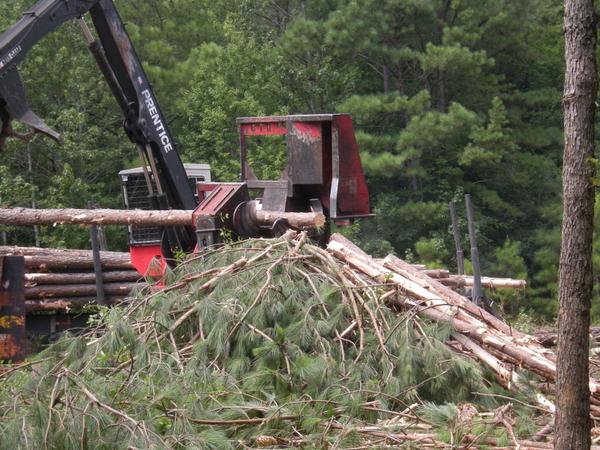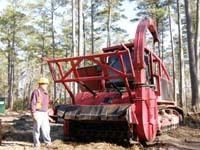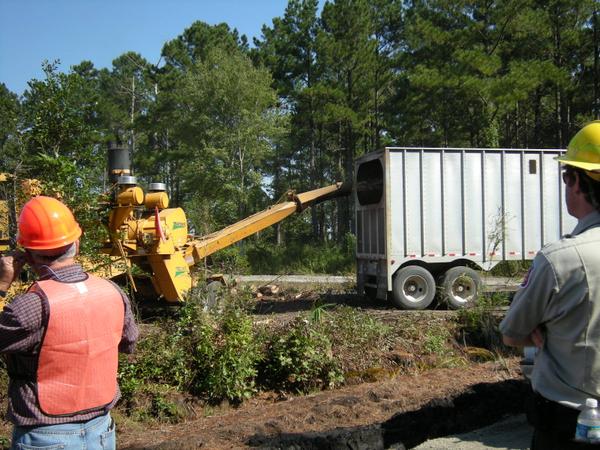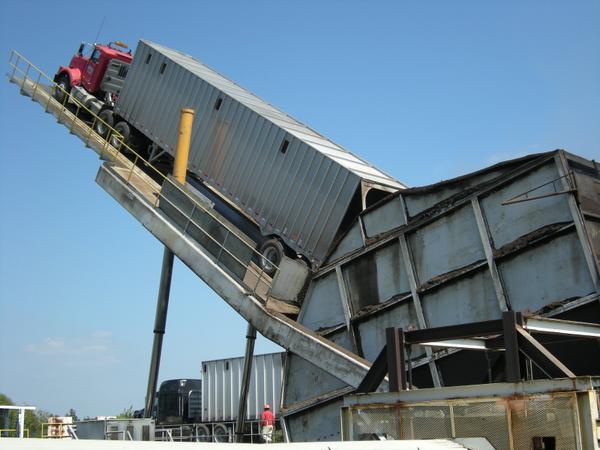Woody biomass harvesting for renewable energy and bio-based products is likely to increase in North Carolina sparked by higher energy prices and government policies to promote renewable energy. Biomass harvests capture and use low=quality, smaller diameter materials and tops, branches and logging debris typically left on site during traditional timber/pulpwood harvest. The expansion of a wood-based energy industry has prompted concerns about intensified forest biomass removal and its impact on water, wildlife, biodiversity and site nutrients. This note reviews common, cost effective strategies that minimize or avoid woody biomass harvest impacts. Sources of information to prevent and mitigate harvest impacts are included.
New and expanded woody biomass markets are developing in the shadow of high energy costs, concern over fossil fuel emissions and legislation to favor renewable energy. Landowners, and the professionals who serve them, need to familiarize themselves with the proven strategies that allow for the harvest of low‐value biomass without negative impacts. Carefully planned woody biomass harvests can economically improve degraded forest stands. Preventing and mitigating unfavorable impacts is imperative if markets for woody biomass are to expand, remain sustainable and be supported by the general public.
Woody biomass includes snags (dead trees), tops, limbs, undersized and “non‐merchantable” stems and brush.
Why Increase Woody Biomass Removal?
Without markets, low‐value forest products like biomass remain on site as residual vegetation or slash (logging debris), brush, stumps and coarse woody debris. Slash and residual vegetation can hinder ongoing forest and wildlife management or require costly site preparation for reforestation. Biofuels generated from woody biomass can pay landowners to have unwanted materials removed from their forest during standard harvest operations. The payoffs are clear: enhanced energy independence, jobs, and healthy rural economy. The question that landowners will need to answer is a profound one: “Is it in my best interest to remove more material from my forest as biomass?” That answer will depend on goals for each property, access to markets, alternative management opportunities, and specific site or stand conditions (soils, sensitive areas and the age, quality and species mix).
Where Biomass Harvesting Makes Sense
Successful woody biomass operations depend upon viable forest products markets, competititve harvesting and transportation costs, price points and a sustainable supply.
Biomass harvest is ideal where a shift to greater productivity is wanted, and when:
- Stands are degraded or under-stocked and need regeneration or restoration.
- Low-quality materials or poor species mix exist or predominate.
- Stands are dense and current markets preclude the commercial sale of overstocked biomass.
- Biomass removal results in improved wildlife habitat, access, or enhanced protection from fire, insect damage and disease.
Biomass harvest is NOT warranted where:
- Markets do not exist in close proximity to the resource (Transportation is cost prohibitive)
- Small diameter material is on the verge of becoming a higher‐valued product and thus, can generate a greater price than biomass by growing it for additional years. (Shortcuts potential value-added opportunities)
- Biomass removal will jeopardize or degrade the multiple forest resources already in place. (Ecologically unsound)
What’s Known About Biomass Removals?
Conventional harvests can leave as much as 25‐45 % of tree biomass on site, therefore, biomass removal can yield revenue or at the very least remove woody material that would ordinarily be a management burden or cost to the landowner. In general, woody biomass materials contain greater nutrient concentrations than the stems extracted in a conventional harvest. This is because nutrient concentrations of tree components generally increase in order of:
Bole (wood only)
<
Bark
<
Branches
<
Foliage (live leaves and needles)
Since branches and small diameter trees have a greater bark, branch and foliage to wood ratio, the nutrient content of woody biomass will be slightly higher than that of pulpwood and sawtimber products. Elemental foliage concentrations for native trees decrease in the order of:
Nitrogen
<
Calcium
<
Potassium
<
Magnesium
<
Phosphorus
Whenever possible, foliage, twigs and small branches should be left on site because of its nutrient richness and light weight: Nutrient rich tree components,when removed from the site, can reduce total nutrient pools on the site over time. Also Leaves are light weight and are cost prohibitive to harvest.. Nutrient rich foliage and twigs create excessive ash when burned for energy, decreasing their receptivity in the marketplace for disposal reasons. Although this “fly ash” can be applied as a fertilizer after biomass is burned, the handling, transport and application adds additional cost.
Experience has shown that tree removal is not detrimental to site productivity. However, the road construction and stream crossing that occur during any harvest need to be done in a manner that minimizes soil disturbance, runoff and erosion. Likewise, harvesting impacts need to balance wildlife habitat and goals for the property. Adherence to the Forest Practice Guidelines to Protect Water Quality and Forestry Best Management Practices will avoid most biomass harvesting impacts. The key to minimizing harvest impact is a proper plan and an efficiently located road networks and logging deck. The use of professional forestry oversight and sustainable forest practices will ensure that negative harvest impacts are minimized.
Strictly adhere to all forest and water protection regulations and recommendations.
Follow these proven prevention steps:
- Protect lakes, water bodies and riparian zones with buffer zones
- Properly locate road, landing and decks outside of riparian areas
- Identify and protect sensitive natural areas by limiting harvest within those areas.
- Retain critical stand‐level wildlife habitat elements (snags, mast trees, downed woody debris den and nest trees)
- Restrict wet‐weather harvesting
To minimize impacts during harvesting, follow these proven mitigation strategies:
- Follow Forest Practice Guidelines for Water Quality Protection
- Implement appropriate Best Management Practices to Protect Water Quality
- Match appropriate equipment to site limitations, especially in wetland and riparian areas
- Avoid or decrease disruption of target wildlife during important breeding, nesting seasons
- Employ longer rotations where possible and economically justifiable
- Minimize biomass harvest frequency and repeated stand-entry with equipment
- Harvest after leaf fall (late fall and winter months) whenever possible
- When dormant season harvest is unavoidable, use processing equipment that removes high nutrient content materials (delimbing gates, and chippers that exclude foliage, twigs, and small branches)
A universal [Forestry] BMP is to minimize the amount of soil disturbance.
Woody biomass for bioenergy and other renewable forest products can be beneficially integrated into existing management for planted and natural forests throughout North Carolina. Careful planning and harvesting that employs proven prevention and mitigation steps can minimize and avoid most negative impacts. Using professional forestry advice and oversight, landowners can identify forestry opportunities where their profitability, management goals and productivity can be enhanced with a planned wood biomass harvest.
Steps to Success for Best Forestry Management
- Have a pre‐harvest plan prepared by an experienced, registered forester
- Adhere to all BMP’s related to soil and water protection
- Restrict equipment use during wet weather; state restrictions in a contract
- Minimize removal of nutrient rich leaves, twigs and small branches
- Employ habitat management practices where practical
- Inspect the site during and post harvest for compliance
- Plan for regeneration before the harvest for species most suited to the site

Chip storage pile at a combined heat and power facility in Scandinavia.
Mark Megalos, NC State CC BY-NC 4.0
Resources on Preventing and Mitigating Harvest Impacts
NC Forest Practices Guidelines Related To Water Quality (FPGs) – 15A NC AC 1I .0100 .0209
North Carolina Forestry Best Management Practices Manual To Protect Water Quality. Amended September 2006.
Sustainable Forestry Initiative® Standard (SFIS) – Objectives 3 and 4 (Water Quality and Conservation of Biological Diversity)

Pine limbs, twigs, and needs awaiting spreading in harvest area.
Mark Megalos, NC State CC BY-NC 4.0
Publication date: Jan. 1, 2019
Reviewed/Revised: Dec. 13, 2019
N.C. Cooperative Extension prohibits discrimination and harassment regardless of age, color, disability, family and marital status, gender identity, national origin, political beliefs, race, religion, sex (including pregnancy), sexual orientation and veteran status.



